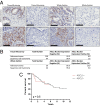ASCL1 is a lineage oncogene providing therapeutic targets for high-grade neuroendocrine lung cancers
- PMID: 25267614
- PMCID: PMC4205603
- DOI: 10.1073/pnas.1410419111
ASCL1 is a lineage oncogene providing therapeutic targets for high-grade neuroendocrine lung cancers
Abstract
Aggressive neuroendocrine lung cancers, including small cell lung cancer (SCLC) and non-small cell lung cancer (NSCLC), represent an understudied tumor subset that accounts for approximately 40,000 new lung cancer cases per year in the United States. No targeted therapy exists for these tumors. We determined that achaete-scute homolog 1 (ASCL1), a transcription factor required for proper development of pulmonary neuroendocrine cells, is essential for the survival of a majority of lung cancers (both SCLC and NSCLC) with neuroendocrine features. By combining whole-genome microarray expression analysis performed on lung cancer cell lines with ChIP-Seq data designed to identify conserved transcriptional targets of ASCL1, we discovered an ASCL1 target 72-gene expression signature that (i) identifies neuroendocrine differentiation in NSCLC cell lines, (ii) is predictive of poor prognosis in resected NSCLC specimens from three datasets, and (iii) represents novel "druggable" targets. Among these druggable targets is B-cell CLL/lymphoma 2, which when pharmacologically inhibited stops ASCL1-dependent tumor growth in vitro and in vivo and represents a proof-of-principle ASCL1 downstream target gene. Analysis of downstream targets of ASCL1 represents an important advance in the development of targeted therapy for the neuroendocrine class of lung cancers, providing a significant step forward in the understanding and therapeutic targeting of the molecular vulnerabilities of neuroendocrine lung cancer.
Keywords: ASCL1 transcriptome; personalized therapy; target discovery.
Conflict of interest statement
The authors declare no conflict of interest.
Figures





References
-
- Jones MH, et al. Two prognostically significant subtypes of high-grade lung neuroendocrine tumours independent of small-cell and large-cell neuroendocrine carcinomas identified by gene expression profiles. Lancet. 2004;363(9411):775–781. - PubMed
-
- Rodriguez E, Lilenbaum RC. Small cell lung cancer: Past, present, and future. Curr Oncol Rep. 2010;12(5):327–334. - PubMed
-
- Guillemot F, et al. Mammalian achaete-scute homolog 1 is required for the early development of olfactory and autonomic neurons. Cell. 1993;75(3):463–476. - PubMed
-
- Johnson JE, Birren SJ, Anderson DJ. Two rat homologues of Drosophila achaete-scute specifically expressed in neuronal precursors. Nature. 1990;346(6287):858–861. - PubMed
Publication types
MeSH terms
Substances
Associated data
- Actions
Grants and funding
LinkOut - more resources
Full Text Sources
Other Literature Sources
Molecular Biology Databases

